Living fossil facts for kids
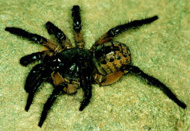
A living fossil is a term for living things that have stayed almost the same for a very, very long time. They look a lot like their ancient ancestors found in fossils. These creatures have survived with very few changes over millions of years. They are still around today, showing us what life might have looked like long ago.
- The Horseshoe crab is a great example of a living fossil. These creatures have looked almost the same since the Ordovician period, about 450 million years ago.
- Crocodilians first appeared about 220 million years ago. They are close relatives of the dinosaurs. Modern crocodiles, however, are a bit newer, dating back about 84 million years.
- Turtles are known from about 215 million years ago. Even though they are very old, people don't always call them living fossils.
- The Tuatara, from New Zealand, is the only survivor of an entire group of reptiles called Sphenodontia. This group was common 200 million years ago.
- The Coelacanth fish is definitely a living fossil. It's a very old type of fish that links fish to the first amphibians. Scientists thought it was extinct for 80 million years! But then, in 1938, one was caught alive off Africa.
- The Ginkgo tree, Ginkgo biloba, is a good plant example. It was thought to be extinct in the wild. But now we know it grows in two small areas in China. The first similar fossils are from 270 million years ago.
- Lingula, a type of shell creature called a brachiopod, has been around since the Ordovician period, 488 million years ago. Modern Lingula look almost exactly like their first fossils.
Living fossils are not exactly the same as their ancestors. But they have lived in similar places and their bodies suggest they lived in the same way. This means their way of life has not changed much over time.
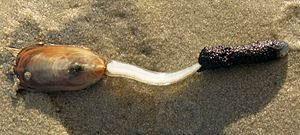
Contents
Amazing Living Fossils: Animals and Plants
Many creatures are known as "living fossils" because they have changed so little. They give us a peek into Earth's ancient past.
Ancient Plants Still Growing
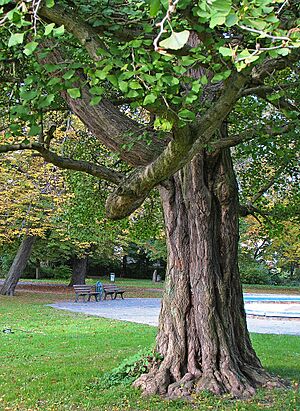
- Pteridophytes (Ferns and their relatives)
- Horsetails – Equisetum
- Tree ferns
- Gymnosperms (Plants with "naked" seeds)
- Angiosperms (Plants that flower)
- Amborella – A plant from New Caledonia, possibly one of the oldest types of flowering plants.
Fungi That Time Forgot
- Neolecta – This type of fungus is very ancient and unique.
Animals That Are Time Travelers
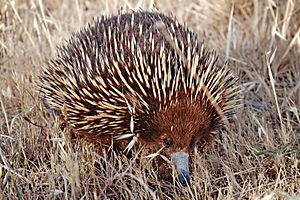
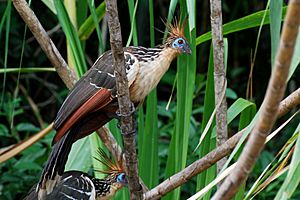
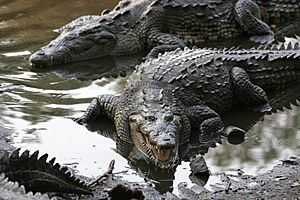
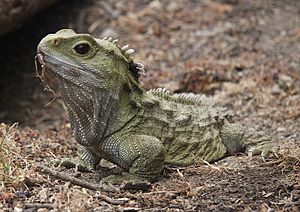
- Mammals
- Monotremes – This group includes the platypus and echidna. They are unique because they are mammals that lay eggs!
- Elephant shrew – These small creatures look like shrews but are related to elephants.
- Okapi – A relative of the giraffe, but with stripes like a zebra.
- Red panda – A unique animal not closely related to other pandas.
- Birds
- Hoatzin – This bird from South America has claws on its wings when it's young.
- Magpie goose – A very old type of waterfowl.
- Reptiles
- Crocodilia – This group includes crocodiles, alligators, and caimans. They have changed little since dinosaur times.
- Tuatara – A reptile from New Zealand that looks like a lizard but is from a much older group.
- Amphibians
- Giant salamanders – Huge amphibians found in Asia and North America.
- Purple frog – A unique frog from India that spends most of its life underground.
- Jawless Fish
- Hagfish – These eel-like creatures are very primitive fish without jaws.
- Bony Fish
- Coelacanth – A famous "living fossil" fish with fleshy fins.
- Gar – Long, armored fish found in North and Central America.
- Queensland lungfish – A fish that can breathe air using a single lung.
- Sturgeons – Large, ancient fish known for their bony plates.
- Sharks
- Frilled shark – A deep-sea shark with a very unusual appearance.
- Goblin shark – Another deep-sea shark with a long, flat snout and sharp teeth.
- Invertebrates
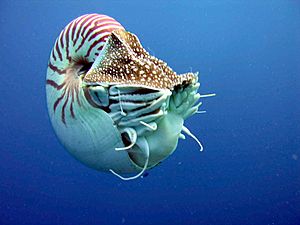

- Insects
- Gladiators – A small group of insects found in Africa.
- Nothomyrmecia – Known as the "dinosaur ant" because of its ancient features.
- Crustaceans
- Stomatopods – Colorful and powerful ocean hunters.
- Triops cancriformis – Also called tadpole shrimp, these small crustaceans look like ancient fossils.
- Molluscs
- Nautilina – This group includes the Nautilus pompilius, a creature with a beautiful spiral shell.
- Vampyroteuthis infernalis – The "vampire squid" is a unique deep-sea creature.
- Other Invertebrates
- Horseshoe crabs – These marine arthropods are famous for their unchanged appearance.
- Onychophorans – Also called velvet worms, these soft-bodied creatures live in humid places.
- Liphistiidae – A family of primitive trapdoor spiders.
Images for kids
-
Elephant shrews look like the extinct Leptictidium from ancient Europe.
-
Ferns were the main plant group in the Jurassic period. Some species, like Osmunda claytoniana, have stayed the same for at least 180 million years.
-
Echidnas are one of few mammals to lay eggs.
-
Tuataras are reptiles, yet retain more primitive characteristics than lizards and snakes.
-
The goblin shark is the only living member of its family, which is about 125 million years old.
-
Nautilus retain the external spiral shell that its other relatives have lost.
See also
 In Spanish: Fósil viviente para niños
In Spanish: Fósil viviente para niños







